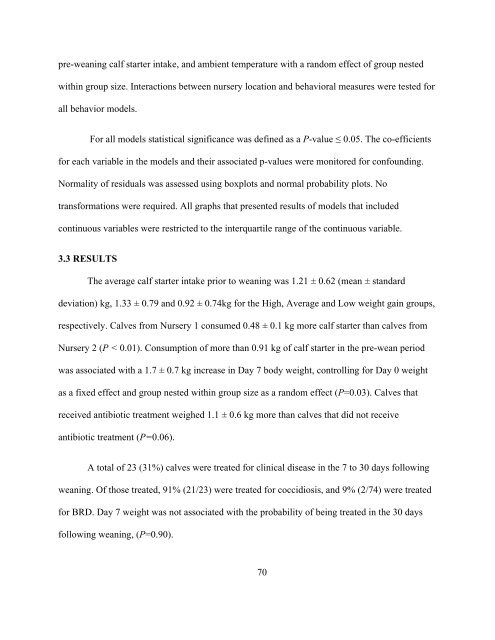Stanton PhD Thesis final_docx - Atrium - University of Guelph
Stanton PhD Thesis final_docx - Atrium - University of Guelph
Stanton PhD Thesis final_docx - Atrium - University of Guelph
You also want an ePaper? Increase the reach of your titles
YUMPU automatically turns print PDFs into web optimized ePapers that Google loves.
pre-weaning calf starter intake, and ambient temperature with a random effect <strong>of</strong> group nested<br />
within group size. Interactions between nursery location and behavioral measures were tested for<br />
all behavior models.<br />
For all models statistical significance was defined as a P-value ≤ 0.05. The co-efficients<br />
for each variable in the models and their associated p-values were monitored for confounding.<br />
Normality <strong>of</strong> residuals was assessed using boxplots and normal probability plots. No<br />
transformations were required. All graphs that presented results <strong>of</strong> models that included<br />
continuous variables were restricted to the interquartile range <strong>of</strong> the continuous variable.<br />
3.3 RESULTS<br />
The average calf starter intake prior to weaning was 1.21 ± 0.62 (mean ± standard<br />
deviation) kg, 1.33 ± 0.79 and 0.92 ± 0.74kg for the High, Average and Low weight gain groups,<br />
respectively. Calves from Nursery 1 consumed 0.48 ± 0.1 kg more calf starter than calves from<br />
Nursery 2 (P < 0.01). Consumption <strong>of</strong> more than 0.91 kg <strong>of</strong> calf starter in the pre-wean period<br />
was associated with a 1.7 ± 0.7 kg increase in Day 7 body weight, controlling for Day 0 weight<br />
as a fixed effect and group nested within group size as a random effect (P=0.03). Calves that<br />
received antibiotic treatment weighed 1.1 ± 0.6 kg more than calves that did not receive<br />
antibiotic treatment (P=0.06).<br />
A total <strong>of</strong> 23 (31%) calves were treated for clinical disease in the 7 to 30 days following<br />
weaning. Of those treated, 91% (21/23) were treated for coccidiosis, and 9% (2/74) were treated<br />
for BRD. Day 7 weight was not associated with the probability <strong>of</strong> being treated in the 30 days<br />
following weaning, (P=0.90).<br />
70

















